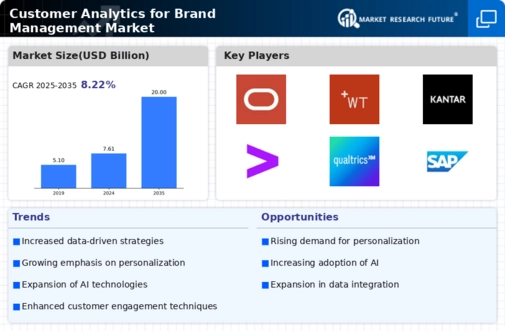Rising Demand for Personalization
The increasing demand for personalized customer experiences is a pivotal driver in the Customer Analytics for Brand Management Market. Brands are leveraging customer analytics to tailor their offerings, ensuring that marketing messages resonate with individual preferences. According to recent data, approximately 80 percent of consumers are more likely to make a purchase when brands offer personalized experiences. This trend compels companies to invest in sophisticated analytics tools that can dissect customer data and provide actionable insights. As brands strive to enhance customer loyalty and engagement, the ability to analyze and interpret customer behavior becomes essential. Consequently, the focus on personalization is likely to propel the growth of the Customer Analytics for Brand Management Market, as businesses seek to differentiate themselves in a competitive landscape.
Increased Focus on Customer Retention
The heightened emphasis on customer retention strategies is a significant driver in the Customer Analytics for Brand Management Market. Businesses are increasingly recognizing that retaining existing customers is often more cost-effective than acquiring new ones. Data indicates that increasing customer retention rates by just 5 percent can lead to a profit increase of 25 to 95 percent. As a result, brands are turning to customer analytics to identify at-risk customers and develop targeted retention strategies. By analyzing customer behavior and feedback, brands can create tailored loyalty programs and personalized communications that foster long-term relationships. This focus on retention not only enhances customer satisfaction but also drives revenue growth, thereby reinforcing the importance of customer analytics in brand management.
Advancements in Data Analytics Technologies
Technological advancements in data analytics are significantly influencing the Customer Analytics for Brand Management Market. The emergence of advanced analytics tools, including predictive analytics and real-time data processing, enables brands to gain deeper insights into customer behavior. For instance, the market for predictive analytics is projected to grow at a compound annual growth rate of over 20 percent in the coming years. These technologies allow brands to anticipate customer needs and preferences, thereby enhancing their marketing strategies. Furthermore, the integration of artificial intelligence and machine learning into analytics platforms is transforming how brands interpret data. This evolution not only streamlines data processing but also enhances the accuracy of customer insights, making it a crucial driver for the Customer Analytics for Brand Management Market.
Expansion of E-commerce and Digital Marketing
The expansion of e-commerce and digital marketing channels is a significant driver in the Customer Analytics for Brand Management Market. As more consumers shift to online shopping, brands are increasingly relying on customer analytics to optimize their digital marketing strategies. Data shows that e-commerce sales are expected to reach over 6 trillion dollars by 2024, underscoring the need for effective analytics to understand online consumer behavior. Brands are utilizing analytics to track customer interactions across various digital touchpoints, allowing for more targeted marketing efforts. This shift not only enhances customer engagement but also drives sales growth. As e-commerce continues to flourish, the role of customer analytics in brand management becomes increasingly critical, positioning it as a key driver in the market.
Growing Importance of Brand Reputation Management
The growing importance of brand reputation management is emerging as a critical driver in the Customer Analytics for Brand Management Market. In an era where information spreads rapidly through social media and online reviews, brands must actively monitor and manage their reputations. Customer analytics provides valuable insights into public perception and sentiment, enabling brands to respond proactively to potential issues. Research suggests that 70 percent of consumers are influenced by online reviews when making purchasing decisions. Consequently, brands are investing in analytics tools that can track customer feedback and sentiment across various platforms. This proactive approach to reputation management not only mitigates risks but also enhances brand loyalty, making it a vital component of the Customer Analytics for Brand Management Market.

















Leave a Comment